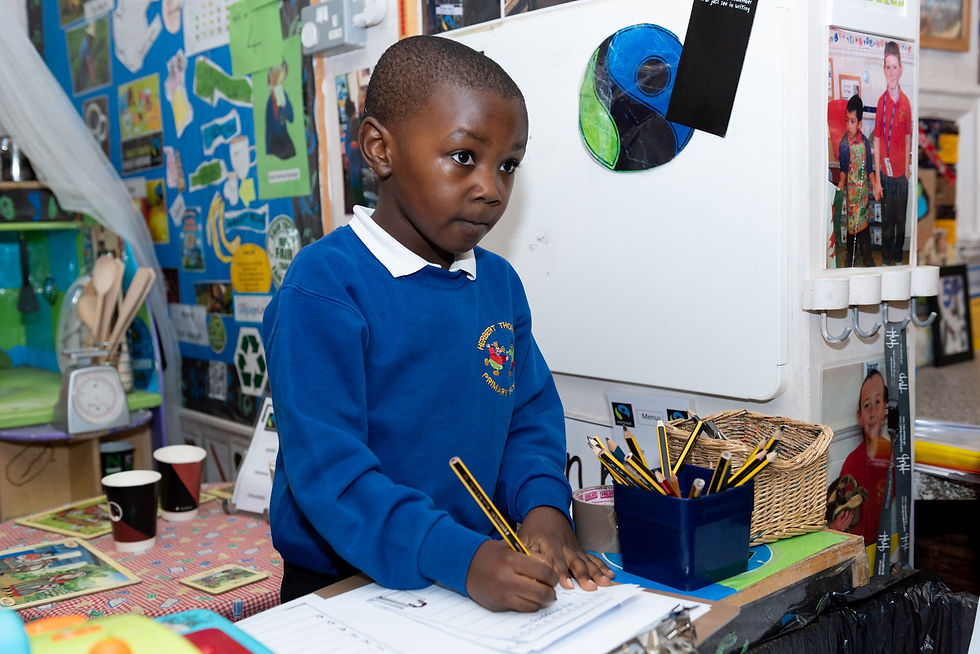Mathematics & Numeracy at Herbert Thompson
We are looking forward to embracing the new Mathematics and Numeracy area of learning her at Herbert Thompson primary School. The new curriculum of Mathematics and Numeracy, by definition, has numeracy at its heart.
Numeracy involves applying and connecting the five mathematical skills in a range of real-life contexts, within the Mathematics and Numeracy Area of Learning and Experience, and the wider curriculum. There are five main areas that have been identified in the new curriculum:
-
Conceptual understanding; having the knowledge to understand and explain a mathematical concept.
-
Communication with symbols.
-
Strategic competence (i.e. formulating problems mathematically in order to solve them).
-
Logical reasoning.
-
Fluency
Our approach to Mathematics and Numeracy at Herbert Thompson Primary aims to develop all these areas in a purposeful and meaningful way for all our pupils.
Foundation Phase
During the Foundation Phase, learners develop their skills, knowledge and understanding of mathematics through oral, practical and play activities. For the Early Years, the children are taught numeracy using ‘Little Big Maths’ techniques; these include games, stories and songs. The children follow very small steps that allow the children to make progress at the appropriate level. In Year 1 and 2 the children then go on to develop their core numeracy through ‘Big Maths’ where once again they follow small steps to make closely monitored progress. They develop a range of flexible methods for working mentally with number, in order to solve problems from a variety of contexts, checking their answers in different ways, moving on to using more formal methods of working and recording when they are developmentally ready.





Cornerstones Imaginative Learning Projects
Through our Cornerstones Imaginative Learning Projects the children enjoy using and applying mathematics in practical tasks, in real-life problems, and within mathematics itself. They use a variety of ICT resources as tools for exploring number, for obtaining real-life data and for presenting their findings.
They develop their use and understanding of mathematical language in context, through communicating/talking about their work. They ask and respond to questions, and explore alternative ideas. They use appropriate mathematical language to explain their thinking and the methods they use to support the development of their reasoning.They explore, estimate and solve real-life problems in both the indoor and outdoor environment. They develop their understanding of measures, investigate the properties of shape and develop early ideas of position and movement through practical experiences. They sort, match, sequence and compare objects and events, explore and create simple patterns and relationships, and present their work in a variety of ways.
Key Stage 2
At Key Stage 2, learners build on the skills, knowledge and understanding they have already acquired during the Foundation Phase.Using ‘Big Maths’ techniques they improve their core numeracy skills through CLIC sessions; Counting, Learn Its, It’s Nothing New and Calculation. They extend their use of the number system, moving from counting reliably to calculating fluently with all four number operations, including in the context of money, in order to solve numerical problems. They try to tackle a problem with a mental method before using any other approach and use written methods of calculation appropriate to their level of understanding.
Big Maths at Herbert Thompson
Core Numeracy is taught using Big Maths techniques as promoted by Andrell Education. This approach clarifies the relationship between core numeracy, which includes the four elements of ‘Counting’ children learn to count; ‘Learn It’s’ where the children learn to remember totals as facts; ‘It’s Nothing New’ where the children learn to apply those facts in new situations through ‘swapping the thing’ being counted and ‘Calculation’ where the children learn to structure all the previous three into a formal calculation (CLIC).
Big Maths follows a five stage model that puts the child at the heart of the learning experience; the teacher will know where the learner currently is, know their next step, relocate the learner using effective teaching, check the learner has understanding by continuous assessment and communicate the next location to the learner as a target. Many children suffer from low confidence in mathematics. They either feel negative about maths as a subject or about their ability to cope with maths, or both. We seek to address this by showing all children that becoming numerate is easy. For children to understand how and why it’s easy, teachers need to understand how and why it is easy and pass on this understanding making learners far more confident.
The children will be taught to understand and use measures and money, understand and use the properties of shapes, understand and use the properties of position and movement, collect, represent and interpret data and understand and use probability either through discrete lessons where the skills are taught or through our Cornerstones Imaginative Learning Projects. Each year group are taught through six imaginative learning projects a year and these allow the children to use all their numeracy skills as outlined in the LNF.
To reinforce their learning and encourage independent learning skills, children are encouraged to complete homework given to them in paper form and through an online system. Children are encouraged to be bilingual in mathematics lessons. They are taught to understand and use the welsh number system and are taught to recognise simple mathematics vocabulary.
